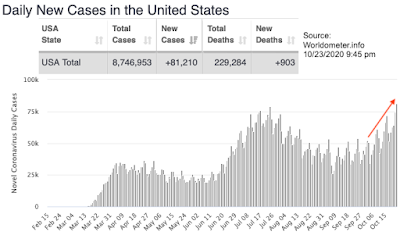The US has set a new record for daily COVID-19 cases today, with 81,210 new cases according to Worldometers.info. The COVID Tracking Project reports an even higher number of 83,010 cases.
In July, the increase of cases was primarily driven by rapid rises in Texas, Florida, California, and Arizona. These states reacted with measures that partially rolled back the "re-opening", for example bar closures and local mask mandates.
In contrast, the current rise in COVID-19 infections is the result of rising case numbers in the vast majority of US states:
 |
| Source and full table: npr.org |
A total of 22 states show an increase in average daily cases and report more than 1,000 cases per day. The top 3 states currently account for about 20% of new cases; during the "second peak" in the summer, this number was closer to 50%.
To stop the current growth in new COVID-19 infections, most of these states would have to increase the stringency of restrictions. But whereas several countries in Europe, where COVID-19 has also been rising rapidly, have announced plans for new lockdowns and other severe measures, such actions seem extremely unlikely in most US states, at least in the near future.
Another important trend in COVID-19 infections is that infections have shifted from metropolitan areas to smaller towns and rural areas:
 |
| From https://covid.cdc.gov/covid-data-tracker/ |
Resistance against anti-COVID measures like mandatory face masks is a lot stronger in most rural areas. At the same time, medical support is often worse, with hospitals mostly located in larger cities, where the frequent sound of ambulances transporting COVID-19 patients alerted every resident about how serious the situation was.
In view of these (and other) factors, it is likely that we will see many more records of COVID-19 infections in the US in the coming weeks and months. Reported COVID-19 deaths have just started to increase from about 700 daily deaths (7-day average) a week ago to more than 800 today. Since reported COVID-19 deaths rise with a delay of at least 2-3 weeks after confirmed case numbers rise, additional increases are inevitable.
Some people in the US will doubtlessly interpret the rising number of COVID-19 cases as a positive sign, hoping that it will help the US to achieve "herd immunity". But we have to look no further than to the rising case numbers in New York, where an estimated 25% to 35% of the population has been infected by COVID-19, to see how far away we are from herd immunity. Close to 9 million confirmed cases in the US may seem like a large number, but still represent less than 3% of the population. Epidemiologists estimate that herd immunity would require at least 60% to 70% of the population to be immune to COVID-19. Even after taking into account that only about one out of 5 COVID-19 infections is reflected in the "confirmed case" numbers, reaching herd immunity through infection would lead to at least one million of additional deaths in the US. Considering what we know about re-infection from other corona viruses, which appears to be common a year or less after the initial infection, it is very questionable if reaching herd immunity "the natural way" is possible at all. But effective vaccines, which could let us reach herd immunity without additional deaths, will not be available in sufficient quantities until the summer of 2021 at the earliest.

No comments:
Post a Comment
Note: Only a member of this blog may post a comment.